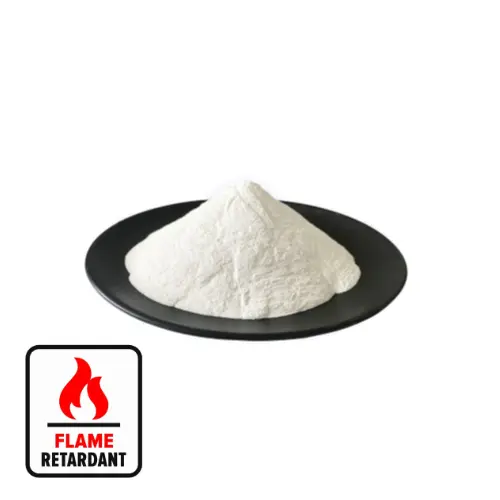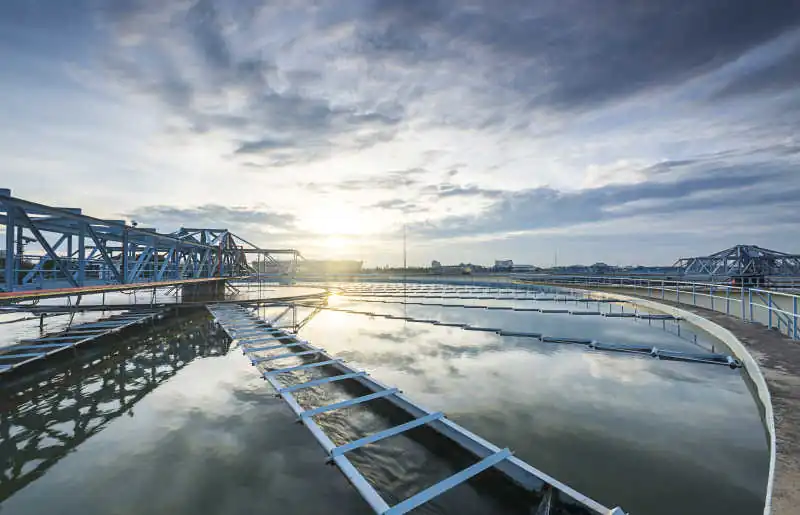Abstract
The preparation method of nano-magnesium hydroxide provided by the present invention utilizes the crystal generation and growth mechanism to control the particle size, adopts magnesium salt solution as raw material, uses sodium hydroxide and ammonia water as mixed precipitants, and prepares nano-magnesium hydroxide by reverse precipitation method. The present invention does not require special equipment, has low investment, and the purity of the obtained product exceeds 99%, and the particle size is generally between 30 and 100 nm.
Description
Nano-magnesium hydroxide preparation method
Technical field
The present invention relates to a method for preparing magnesium hydroxide, in particular to a method for preparing nano-magnesium hydroxide.
Background technology
Magnesium hydroxide is an additive inorganic flame retardant with the triple functions of filling, flame retardant and smoke suppression, which can be used for flame retardant of various polymers. In addition, magnesium hydroxide can also be used for flue gas desulfurization, treatment of lead-containing wastewater and wastewater deammoniation and dephosphorization in environmental protection, and has different degrees of application in acid rain soil treatment, food and feed additives, oil additives, agricultural magnesium fertilizers, cigarette paper smoke suppression coatings, and biological and pharmaceutical preparations. It is a recognized environmentally friendly green chemical product.
There are many methods for preparing magnesium hydroxide, but there are three main processes of production significance (see “Inorganic Salt Industry Handbook” second edition, volume 2, pages 1050-1054), namely, synthesis method, dolomite selective calcination method and electrolytic brine method. Among them, the dolomite selective calcination method is only used for the production of magnesium hydroxide with low purity requirements, and the energy consumption of the electrolytic brine method is too high, and its application is very limited. Therefore, the most widely used production process at present is chemical synthesis, among which the representative synthesis processes (see “Inorganic Chemical Products”, edited by Jason Situ, page 320) are brine-lime method, brine-ammonia method and magnesia-hydrochloric acid-ammonia method, but these processes have many shortcomings: either there is gelation phenomenon, and the smaller the precipitated particles, the more serious the gelation phenomenon, which causes great difficulties in filtering and washing the product; or the pH value of the system is difficult to control, and the yield of the product is low; or the product is prone to secondary coagulation during precipitation and filtration, and ultimately nano-level ultrafine particles cannot be obtained.
At present, there are several invention patents disclosed about the preparation method of nano-grade magnesium hydroxide: CN1332116A uses soluble magnesium salt and alkali to synthesize magnesium hydroxide with an average particle size between 10 and 200 nm through a homogeneous fluid method through a forced precipitation reaction. The process is simple and convenient, but the particle size distribution of the obtained magnesium hydroxide is relatively wide, and strictly speaking, a particle size exceeding 100 nm is no longer a nanoparticle; CN1341694A uses a refined magnesium chloride solution obtained from old brine or magnesite and industrial ammonia water or ammonia gas as raw materials, or uses a magnesium sulfate solution and industrial ammonia water or ammonia gas as raw materials, adopts supergravity (rotating packed bed) technology, and uses a liquid-liquid phase reaction or a gas-liquid phase reaction mode to prepare magnesium hydroxide with an average particle size between 35 and 90 nm. It is characterized by a simple process flow. , the particle size is uniform, but special equipment – rotating packed bed (super gravity) is required, and the equipment investment is relatively large; CN1356361A uses natural brucite or sintered magnesium oxide as raw materials, and prepares magnesium hydroxide with an average particle size of less than 100nm by wet grinding. This method is the simplest, but it can only produce magnesium hydroxide with low purity requirements; CN1361062A uses a fully back-mixed liquid membrane reactor with a liquid-liquid two-phase co-precipitation reaction to carry out a co-precipitation reaction of magnesium salt and alkali solution to prepare magnesium hydroxide with an average particle size between 62 and 92nm. This method is similar to CN1341694A, and the obtained magnesium hydroxide particles have a uniform particle size distribution, but the processing cost of the required special equipment – the fully back-mixed liquid membrane reactor is expensive (the gap between the rotor and the stator must be controlled at 1 to 20μm), and the equipment is difficult to maintain.
In summary, the existing method for preparing high-purity nano-scale magnesium hydroxide particles requires special equipment, large investment, and high operating and maintenance costs.
Content of the invention
The purpose of the present invention is to provide a method for preparing nano-magnesium hydroxide with low investment and low operation and maintenance costs.
The method for preparing nano-magnesium hydroxide provided by the present invention is to control the particle size by using the crystal formation and growth mechanism, using magnesium salt solution as raw material, sodium hydroxide and ammonia water as mixed precipitants, and preparing nano-magnesium hydroxide by reverse precipitation method. The specific process is as follows:
① The magnesium salt is prepared into an aqueous solution with a certain mass concentration, heated to a certain temperature for standby;
② Sodium hydroxide, ammonia water and water are used to prepare a mixed precipitant with a certain pH value, heated to a certain temperature for standby;
③ Prepared into an ethanol aqueous solution with a certain mass concentration, controlled at a certain temperature for standby:
④ The magnesium salt solution is quickly added to the mixed precipitant under intense stirring to carry out nucleation reaction;
⑤ After filtering, washing and vacuum drying, nano-magnesium hydroxide is obtained.
The above-mentioned magnesium salt solution can be magnesium chloride or magnesium nitrate, with a concentration of 5-13%, and the heating temperature can be 40-80°C.
The pH value of the above-mentioned mixed precipitant is greater than 10, and the heating temperature can be 40-80°C.
The above nucleation reaction is to add the magnesium chloride (or magnesium nitrate) aqueous solution to the mixed precipitant quickly under intense stirring, react for 1 to 30 minutes, and then pour it into the ethanol aqueous solution under ultrasonic vibration, keep it for 10 to 120 minutes for 1 to 30 minutes.
The mass concentration of the above ethanol aqueous solution is 50 to 90%, and the temperature is controlled at -10 to 20 ° C.
If magnesium hydroxide needs surface modification, sodium stearate (or anionic surfactant, silane coupling agent) sodium stearate or anionic surfactant, silane coupling agent can be dissolved in ethanol aqueous solution.
In the process of preparing nano-grade magnesium hydroxide by the process provided by the present invention, the magnesium chloride (or magnesium nitrate) solution is reversely added to the mixed precipitant under intense stirring, so that the crystal nucleation reaction can be completed instantly and the pH value of the system can be accurately controlled. The above reaction solution is reversely poured into the low-temperature ethanol aqueous solution under ultrasonic vibration, making full use of the difference in the solubility of magnesium hydroxide in media of different properties, further strengthening the crystal nucleation reaction, and the effect of ultrasonic vibration can avoid the growth and agglomeration of nanoparticles to the greatest extent. The introduction of ethanol components in the system can not only completely eliminate the gelation phenomenon, but also make it easier to filter and wash the product.
The process provided by the present invention is used to prepare nano-magnesium hydroxide. The process is simple, convenient and easy to operate, does not require special equipment, has low investment, and is easy to control process parameters. The purity of the obtained product exceeds 99%, and the particle size is generally between 30 and 100 nm.
Specific implementation method
Example 1
First, 50.8 g of magnesium chloride (MgCl2·6H2O) is dissolved in 345 g of water to prepare a magnesium chloride aqueous solution with a mass concentration of about 6%, and heated to 80°C for standby use; 30 ml of ammonia water with a concentration of 25-28% is mixed with 90 g of water, and pH≈14 is adjusted with 40% sodium hydroxide solution, and heated to 70°C for standby use; 150 ml of ethanol aqueous solution with a mass concentration of 90% is prepared, and its temperature is reduced to -8°C for standby use. Then, under vigorous stirring, the magnesium chloride aqueous solution is quickly added to the mixed precipitant. After reacting for 20 minutes, it is poured into the ethanol aqueous solution under ultrasonic vibration, maintained at low temperature for 30 minutes, and finally filtered, washed, and vacuum dried to obtain magnesium hydroxide. The laser particle size analyzer measured the product particle size range between 30 and 80 nm, the average particle size is 68 nm, and the elemental analysis method measured its purity to be 99.9%.
Example 2
First, 50.8 g of magnesium chloride (MgCl2·6H2O) was dissolved in 132 g of water to prepare a magnesium chloride aqueous solution with a mass concentration of about 13%, and heated to 80°C for use; 40 ml of ammonia water with a concentration of 25-28% was mixed with 200 g of water, and the pH was adjusted to 13 with 40% sodium hydroxide solution, and heated to 60°C for use; 200 ml of ethanol aqueous solution with a mass concentration of 60% was prepared, and its temperature was reduced to 5°C for use. Then, under vigorous stirring, the magnesium chloride aqueous solution is quickly added to the mixed precipitant. After reacting for 10 minutes, it is poured into the ethanol aqueous solution under ultrasonic vibration, maintained at low temperature for 30 minutes, and finally filtered, washed, and vacuum dried to obtain magnesium hydroxide. The laser particle size analyzer measured the product particle size range between 30 and 100 nm, the average particle size is 76 nm, and the elemental analysis method measured its purity to be 99.2%.
Example 3
First, 50.8 g of magnesium chloride (MgCl2·6H2O) is dissolved in 187 g of water to prepare a magnesium chloride aqueous solution with a mass concentration of about 10%, and heated to 80°C for use; 48 ml of ammonia water with a concentration of 25-28% is mixed with 150 g of water, and the pH is adjusted to 11 with 40% sodium hydroxide solution, and heated to 50°C for use; 180 ml of ethanol aqueous solution with a mass concentration of 70% is prepared, and its temperature is reduced to -2°C for use. Then, under vigorous stirring, the magnesium chloride aqueous solution is quickly added to the mixed precipitant. After reacting for 3 minutes, it is poured into the ethanol aqueous solution under ultrasonic vibration, maintained at low temperature for 30 minutes, and finally filtered, washed, and vacuum dried to obtain magnesium hydroxide. The laser particle size analyzer measured the product particle size range between 40 and 95 nm, the average particle size is 72 nm, and the elemental analysis method measured its purity to be 99.3%.
Example 4
First, 128.2 g of magnesium nitrate [Mg(NO3)2·6H2O] is dissolved in 613 g of water to prepare a magnesium chloride aqueous solution with a mass concentration of about 10%, and heated to 80°C for use; 45 ml of ammonia water with a concentration of 25-28% is mixed with 100 g of water, and the pH is adjusted to > 14 with 40% sodium hydroxide solution, and heated to 60°C for use; 200 ml of ethanol aqueous solution with a mass concentration of 80% is prepared, and its temperature is reduced to -5°C for use. Then, under intense stirring, the magnesium nitrate aqueous solution is quickly added to the mixed precipitant, reacted for 10 minutes, poured into the ethanol aqueous solution under ultrasonic vibration, maintained at low temperature for 30 minutes, and finally filtered, washed, and vacuum dried to obtain magnesium hydroxide. The laser particle size analyzer measured the product particle size range between 30 and 90 nm, the average particle size was 54 nm, and the elemental analysis method measured its purity to be 99.1%.


